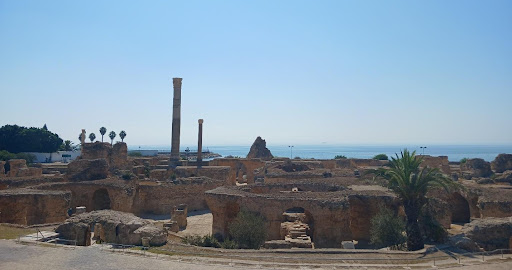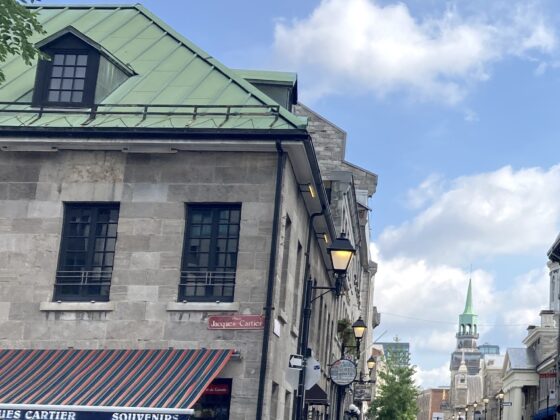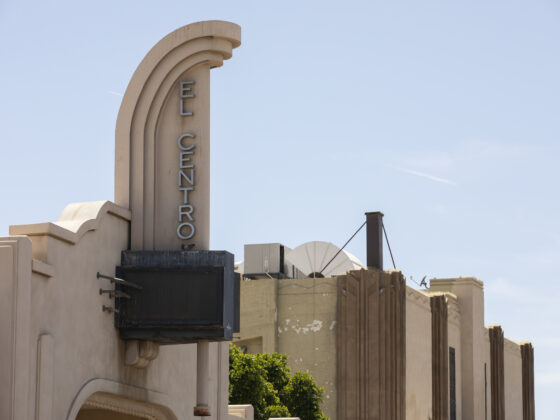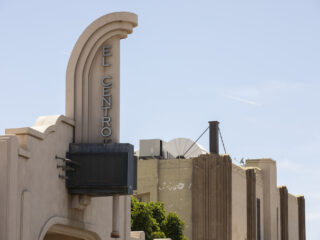By Mina Đurić
The glimpse of dawn separates a thin line, which, from the plane, seems like just a handhold between Sicily and Tunisia. Today, the measures of the values of diversity and multiculturalism, through the historical waves of Mediterranean trade and the hunger for power, echo the ancient world when this region was a point of battle, force, and pain. But tracing the rhythm of Virgil’s famous epic The Aeneid, “[…] out of sight of Sicily’s isle, in deeper water” (Bk I: 35; trans. by H. R. Fairclough), there lay the shadows of the city of stories, dreams, love, and suffering: “There was an ancient city, Carthage (held by colonists from Tyre), | opposite Italy, and the far-off mouths of the Tiber, | rich in wealth, and very savage in pursuit of war” (The Aeneid, Bk I: 12-14). Why do the ancient traces of this city, once destroyed and nowadays kept deeply in the ruins of its Roman successor, remain so profoundly influential in the consciousness of the literary traveler even today?

In the delicate blend of architectural styles spanning centuries of diverse cultural influences – ranging from ancient Phoenician and Roman to Oriental, Andalusian, and Moorish, alongside colonial French and authentic Tunisian – this part of North Africa preserves the allure of secrets that are open yet never fully attainable. The vast recognition of a global self also conceals the truth of an ever-(in)elusive possibility of achieving totality. This region somehow always retains the essence of the burnt and, in art, reborn city of Dido, a refuge of love and the incomplete tale of a potential locus amoenus for her and Aeneas: “[…] For love of a wife | are you now building the foundations of high Carthage | and a pleasing city? Alas, forgetful of your kingdom and fate!” (The Aeneid, Bk IV: 265-267).
Dido is a wanderer, a refugee fleeing danger at home, a rebel, an outsider in one paradigm, and, at the same time, the founder of a new space. She is an organizer, ruler, and leader of young people, inspiring them: “Queen Dido, of loveliest form, reached the temple, | with a great crowd of youths accompanying her” (The Aeneid, Bk I: 496-497). She is an adaptable survivor, an amicable transformer, a negotiable and cunning contributor to the city, and a generous host to the guests in her home, including Aeneus: “[…] so she carried herself, joyfully, | amongst them, furthering the work, and her rising kingdom” (The Aeneid, Bk I: 504-505).
As a mythical symbol of this side, the queen of the harbour is an inevitable part of the gathering – a collector in the global Mediterranean network of wishes, goals, and passions. Dido’s Carthage’s creative energy is a glorious purpose of renewed life in arts. If Dido were a contemporary citizen, she would know that Carthage would never be empty, even without Aeneas. The impossibility of the feeling of absence is not just because of everyday tourists but also because strangers and locals will always need a welcoming place to experience and repeat the wholeness of narration of love and loss. And they can find it in the Tunisian area of artistic repetitions of Dido’s Carthage.
Even if “Dido’s Lamentation” is one of the impressive, soft, luminous ultimate variations of being, described musically in Henry Purcell’s opera Dido and Aeneas, the most intensive verbal leitmotif here is connected with remembrance. Many literary works, following Vergil’s poetics or putting themselves in the creative dialogues, remembered Dido. In Ovid’s The Heroides readers can find the creative imaginations of Dido’s letter to absent Aeneus with the questions – “Where might you create a city as good as Carthage, | and look out on your people from its high fortress? | […] where would you find a wife, to love you like this? (VII; trans. by A. S. Kline). That kind of unfinished love is also remembered in Dante’s “Inferno” of The Divine Comedy, where the shadow of Dido is described as – “The next is she who killed herself for love” (Canto 5, trans. by Henry Wadsworth Longfellow). In delicate contrast to the previous in Marlowe’s The Tragedy of Dido: Queen of Carthage, she is fearless, dominantly strong and “[…] called a second Helena” (1599). Collecting all different aspects is the imaginary Didonian way of the ruling future because that is the secret code incorporated in many later countries and cultures that artistically echoes Dido’s Carthage.

Exotic mixtures of perfume shapes, door colors on the walls, and the tastes of the sea and sun add to the luxury of a part of this continent that seeks to be everything. The change following the times of societal transformation strives to be accessible to many foreigners, yet it still retains the feelings of emigration among some young Tunisians. This metamorphosis somehow reflects the root of the perception of Dido’s Carthage: always present, always disappearing, and continually being rediscovered in the new garments of “[…] the country and strongholds of this new Carthage” (The Aeneid, Bk I: 298). How many famous female cities are in the world (of literature), and what is their meaning?
Dido’s desire to gather everyone within the walls of her city and keep Aeneas through marriage while managing the overpopulation in a well-organized manner within the confined space can be strikingly reflected in modern Tunisia. Visitors from all over the globe encounter an evening scene of families, cousins, and friends of all generations united, among others, on the self-claimed benches in Tunisian cities, sharing stories near the sea. It seems they are perpetually in anticipation, joyfully embracing the present moment and the ebb and flow of time. This sense of belonging and community, while unconsciously echoing Dido’s hospitality and generosity, does not carry the tragic undertones of her myth. Instead, it represents a contemporary version of Dido’s legacy that embraces waiting and travelling. This artistic interpretation of Dido’s Carthaginian space suggests a dynamic adaptability and the capacity for renewal.
On the streets of contemporary Tunisian cities, music is rarely heard, except for some traditional string instruments accompanied by the ritual sensitivity of the performing voice or in singing open visitors trains, followed by clapping of the audience. However, in resorts, mainly catering to tourists and foreigners, a popular song, “Waka Waka (This Time for Africa),” is performed with a slight alteration: instead of the original line “’Cause this is Africa,” the performer sings “’Cause this is Tunisia.” It’s accompanied by a welcoming smile and a warm “marhaba.” “Marhaba” also refers to the lively artistic senses of Dido’s Carthage, which lives strongly among literary travelers today.
Mina Đurić is an Associate Professor of 20th and 21st-century literature at the University of Belgrade, Faculty of Philology. Her research focuses on comparative literature, interdisciplinary studies of modern and contemporary Slavic literatures in the context of world literature, Nobel Prize literature, literary theory, music, digital literature, and translation. Her doctoral dissertation was on the modernization of 20th-century Serbian prose in relation to the creative reception of James Joyce’s literary works. In addition to numerous papers and edited books, she is the author of an interdisciplinary monograph on modernist literature and music, “Transmusicalization of the Text: The Music of Serbian Modernist Literature” (in Serbian, 2022), and the co-author of a publication on Poland in Serbian Literature of the 20th Century (published by the Embassy of the Republic of Poland in Belgrade, 2023).










